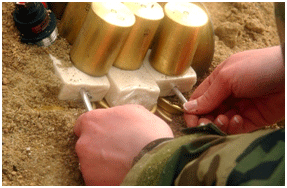Between 1979 and 2005, the Bureau of Alcohol, Tobacco, Firearms and Explosives (ATF) documented more than 27,000 bombing and attempted bombings in the United States. Two of the most significant, the 1993 bombing of the World Trade Center and the 1995 bombing of the Alfred P. Murrah Federal Building, prompted Congress to pass the Antiterrorism and Effective Death Penalty Act of 1996 (the Act).
The Act, signed into law on April 24, 1996, generally makes it unlawful to manufacture, import, transfer, receive, or possess any plastic explosive that does not contain a detection agent. The detection agents are designed to render the explosives detectable by vapor-detection equipment or canines. The regulations implementing the Act are found at 27 CFR 555.180 – 555.186.
According to the Act, persons in possession of unmarked plastic explosives on April 24, 1996, other than any agency of the United States (including any military reserve component) or the National Guard of any State, were required to report to the Bureau of Alcohol, Tobacco and Firearms and Explosives (ATF) certain information regarding the plastic explosives they possessed. The Act provided a 3-year "use-up" period for unmarked plastic explosives manufactured or imported before April 24, 1996, except for materials possessed by any agency of the United States having a military or police function. All possessors of unmarked plastic explosives—except for the military and agencies with police functions—should have used, destroyed, or marked their materials with a detection agent by April 24, 1999.

Military and Federal Law Enforcement Exception
The Act provided a 15-year "use-up" period for the military and Federal law enforcement agencies, beginning on June 21, 1998 (the date of entry into force of the Convention on the Marking of Plastic Explosives with respect to the United States). ATF would like to remind the military and all Federal agencies having a law enforcement function of their obligation under the Act to use, destroy, or mark any stocks of unmarked plastic explosives in their possession by June 21, 2013.
 Finally, it should be noted that the regulations provide for certain exceptions to the marking requirement. Specifically, the regulation at 27 CFR 555.182 states that it is an "affirmative defense" if the proponent proves by a preponderance of evidence that the plastic explosive consists of a small amount of plastic explosive intended for and utilized solely in lawful research; development and testing of new explosives; training in explosives detection or development or testing of explosives detection equipment; or forensic science purposes. The regulation further specifies an affirmative defense for materials that were, or would be, incorporated into a military device in the United States, and would remain an integral part of such a device. Such devices must be, or be intended to become, property of the military or a Federal agency performing a police function. Any questions regarding the requirements of the Act, including use-up periods, detection agents, and affirmative defense issues should be directed to the Explosives Industry Programs Branch at 202-648-7120.
Finally, it should be noted that the regulations provide for certain exceptions to the marking requirement. Specifically, the regulation at 27 CFR 555.182 states that it is an "affirmative defense" if the proponent proves by a preponderance of evidence that the plastic explosive consists of a small amount of plastic explosive intended for and utilized solely in lawful research; development and testing of new explosives; training in explosives detection or development or testing of explosives detection equipment; or forensic science purposes. The regulation further specifies an affirmative defense for materials that were, or would be, incorporated into a military device in the United States, and would remain an integral part of such a device. Such devices must be, or be intended to become, property of the military or a Federal agency performing a police function. Any questions regarding the requirements of the Act, including use-up periods, detection agents, and affirmative defense issues should be directed to the Explosives Industry Programs Branch at 202-648-7120.


